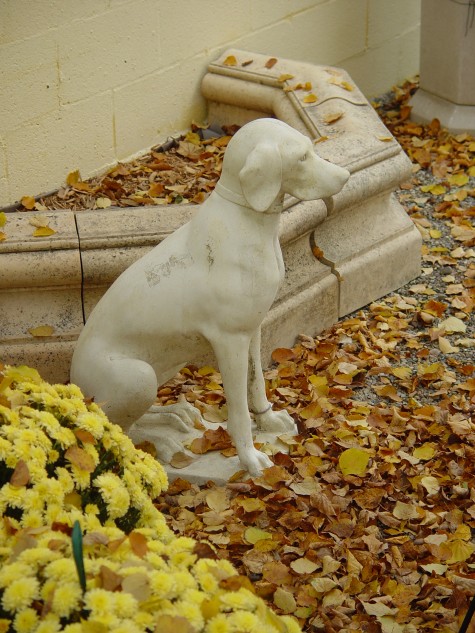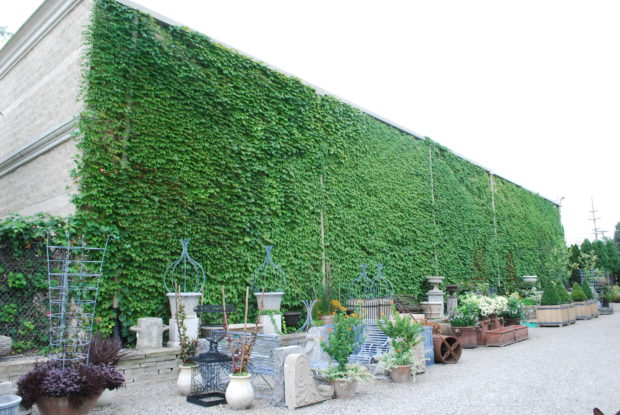 I have been writing about the Boston ivy growing on the walls of the buildings surrounding us for a number of years. A storage business put up buildings all around Detroit Garden Works many years ago. Some of those buildings proved to be on our property after an as-built survey. We settled the problem amicably. They ceded 6 feet of their property opposite the front door of our building, as pictured above, in return for our tolerance of their encroachment on our property in the back. That giant cream colored concrete wall was visually intrusive on our space, and oppressively tall. We opted for a landscape solution. Of course! 10 Boston ivy in 2 gallon pots were planted in regular intervals all along that wall close to 20 years ago. It took the better part of 15 years for that ivy to cover that wall. Cover that wall, it has.
I have been writing about the Boston ivy growing on the walls of the buildings surrounding us for a number of years. A storage business put up buildings all around Detroit Garden Works many years ago. Some of those buildings proved to be on our property after an as-built survey. We settled the problem amicably. They ceded 6 feet of their property opposite the front door of our building, as pictured above, in return for our tolerance of their encroachment on our property in the back. That giant cream colored concrete wall was visually intrusive on our space, and oppressively tall. We opted for a landscape solution. Of course! 10 Boston ivy in 2 gallon pots were planted in regular intervals all along that wall close to 20 years ago. It took the better part of 15 years for that ivy to cover that wall. Cover that wall, it has.
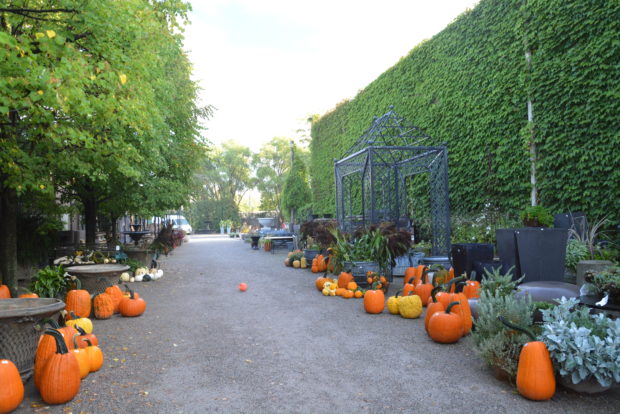 That leafy green wall is a delight. No one needs to squint, walking down the drive. Our driveway is garden like, no matter the season. This intermittent planting of Boston ivy vines in 2 gallon pots has produced a thriving green wall almost 100 feet long, and 20 feet high. There has never been any need for special care, feed, or supplementary irrigation. We do water when conditions are extremely dry, and when we think to water. Otherwise, we only take the time to enjoy the look. The science of how leaves change color is not totally understood, but my oversimplified version is as follows. Leaves have 3 major pigments integral to their structure. Chlorophyll, a primary pigment which gives leaves their green color, is necessary for photosynthesis. The production of food to sustain life is indeed primary. Photosynthesis is a chemical reaction between sunlight and chlorophyll, the upshot of which enables leaves to manufacture sugar. Sugar? Another word for food. The other pigments hidden by the green that chlorophyll dominates are red and yellow pigments.
That leafy green wall is a delight. No one needs to squint, walking down the drive. Our driveway is garden like, no matter the season. This intermittent planting of Boston ivy vines in 2 gallon pots has produced a thriving green wall almost 100 feet long, and 20 feet high. There has never been any need for special care, feed, or supplementary irrigation. We do water when conditions are extremely dry, and when we think to water. Otherwise, we only take the time to enjoy the look. The science of how leaves change color is not totally understood, but my oversimplified version is as follows. Leaves have 3 major pigments integral to their structure. Chlorophyll, a primary pigment which gives leaves their green color, is necessary for photosynthesis. The production of food to sustain life is indeed primary. Photosynthesis is a chemical reaction between sunlight and chlorophyll, the upshot of which enables leaves to manufacture sugar. Sugar? Another word for food. The other pigments hidden by the green that chlorophyll dominates are red and yellow pigments.
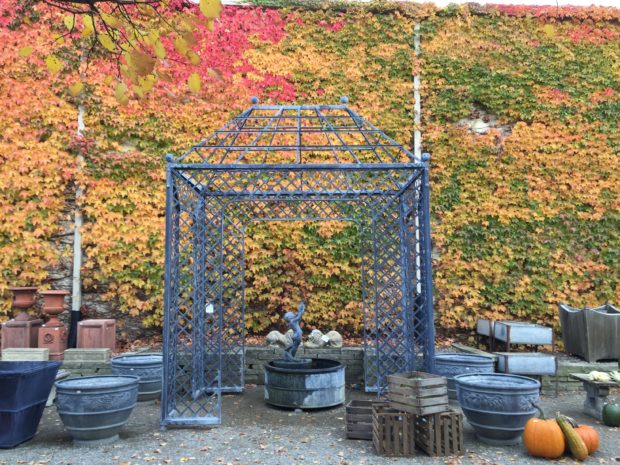 Every gardener is aware that our daylight hours are growing shorter. Leaves respond to a shorter day length by slowing their production of chlorophyll. This makes sense. The slowing of the production of chlorophyll is one of many mechanisms in plants triggered by the shortening days that directs them to slow down their growth before the end of the growing season. Once the production of chlorophyll wanes, the red and yellow pigments in leaves begin to show. Fall color. The temperature and rainfall may play a roll in the timing of fall color, but the most significant factor is day length.
Every gardener is aware that our daylight hours are growing shorter. Leaves respond to a shorter day length by slowing their production of chlorophyll. This makes sense. The slowing of the production of chlorophyll is one of many mechanisms in plants triggered by the shortening days that directs them to slow down their growth before the end of the growing season. Once the production of chlorophyll wanes, the red and yellow pigments in leaves begin to show. Fall color. The temperature and rainfall may play a roll in the timing of fall color, but the most significant factor is day length.
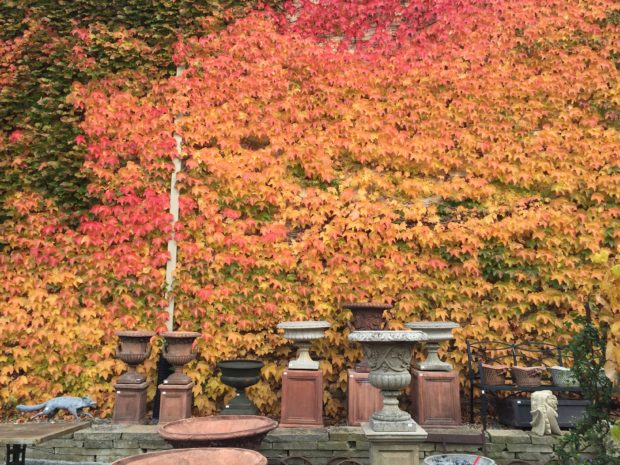 The popular hoopla about the dangers presented to masonry walls by Boston ivy is well documented. I am sure there are still those who suggest that a covering of Boston ivy will bring down a building. This has not been my experience. How this vine grips a vertical surface is serious. The vine sends out sucker discs, or gripping pads, which hold the branches of the vine close to the wall. Have I ever seen any damage to our walls in 20 years-no. Many universities in the eastern part of the US, popularly known as Ivy league schools, feature buildings dressed to the nines in Boston ivy. They have been that way a long time. Our green wall requires little in the way of care. But it provides a stunning backdrop for all we have going on at the shop in every season. Once the season turns from summer to fall, I can count on the Boston ivy to tell a spectacular fall story. Every year is different. Some areas turn red, and others are yellow. Some spots are a mix of red and peach and yellow. Some leaves stay green until they drop. Others are a fiery red. Every year, that tapestry of color created by these 10 vines is different. Every year, the fall color is breathtaking. I have yet to tire of it.
The popular hoopla about the dangers presented to masonry walls by Boston ivy is well documented. I am sure there are still those who suggest that a covering of Boston ivy will bring down a building. This has not been my experience. How this vine grips a vertical surface is serious. The vine sends out sucker discs, or gripping pads, which hold the branches of the vine close to the wall. Have I ever seen any damage to our walls in 20 years-no. Many universities in the eastern part of the US, popularly known as Ivy league schools, feature buildings dressed to the nines in Boston ivy. They have been that way a long time. Our green wall requires little in the way of care. But it provides a stunning backdrop for all we have going on at the shop in every season. Once the season turns from summer to fall, I can count on the Boston ivy to tell a spectacular fall story. Every year is different. Some areas turn red, and others are yellow. Some spots are a mix of red and peach and yellow. Some leaves stay green until they drop. Others are a fiery red. Every year, that tapestry of color created by these 10 vines is different. Every year, the fall color is breathtaking. I have yet to tire of it.
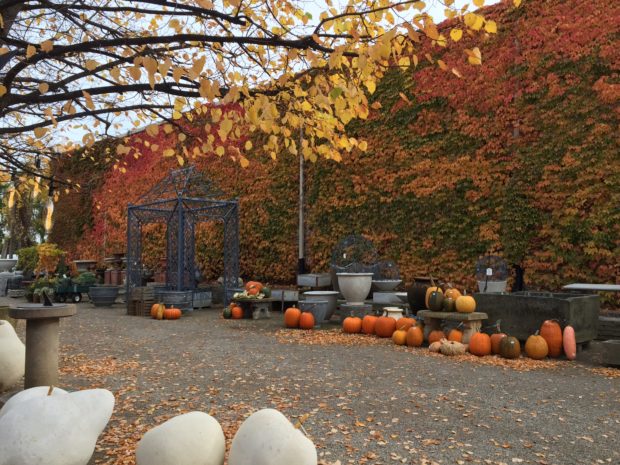 Boston ivy is a very vigorous and self supporting vine. It needs a lot of width, a lot of height, and a huge space to truly represent all that it can be. Who knew that 10 2 gallon pots of Boston ivy would look like this, 20 years later.
Boston ivy is a very vigorous and self supporting vine. It needs a lot of width, a lot of height, and a huge space to truly represent all that it can be. Who knew that 10 2 gallon pots of Boston ivy would look like this, 20 years later.
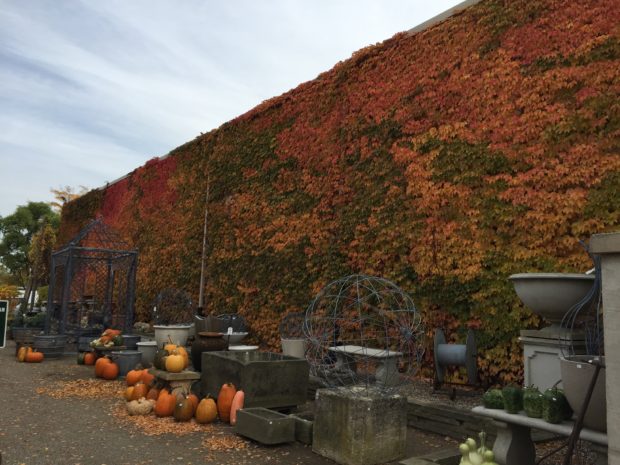 The next 10 days at Detroit Garden Works will feature this particular year’s tapestry of fall color on the Boston ivy. Stop by, should you have a mind to see the 2016 version. Too far away? I will post more pictures. The easy part is my picture taking. The miraculous part belongs to nature. Thank you, Madame Nature, for this moment.
The next 10 days at Detroit Garden Works will feature this particular year’s tapestry of fall color on the Boston ivy. Stop by, should you have a mind to see the 2016 version. Too far away? I will post more pictures. The easy part is my picture taking. The miraculous part belongs to nature. Thank you, Madame Nature, for this moment.

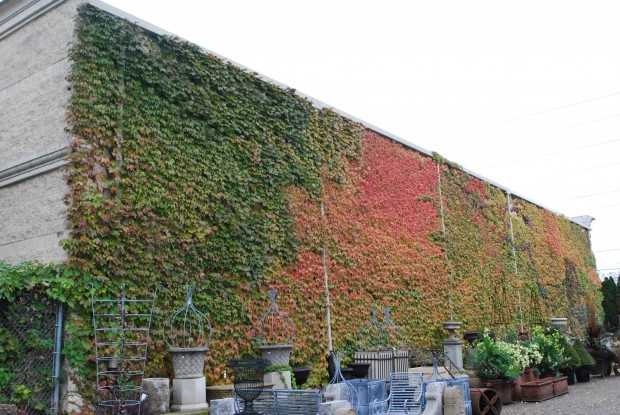
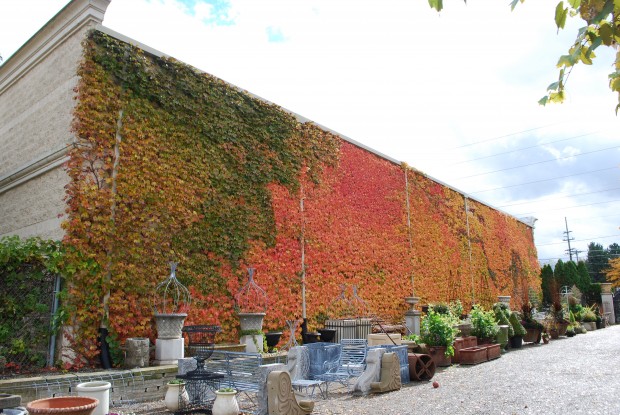
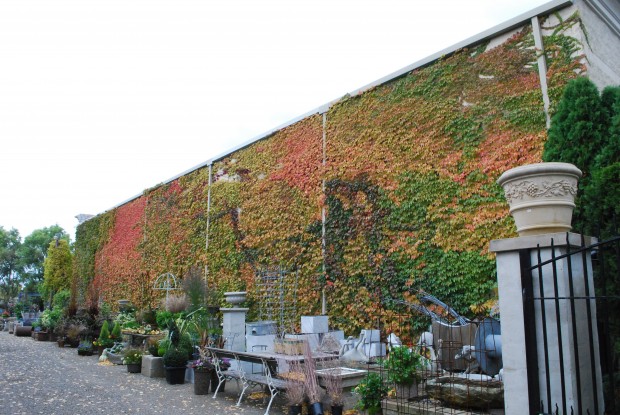
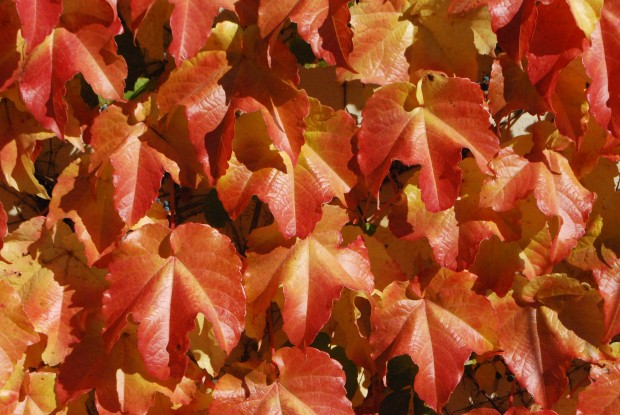
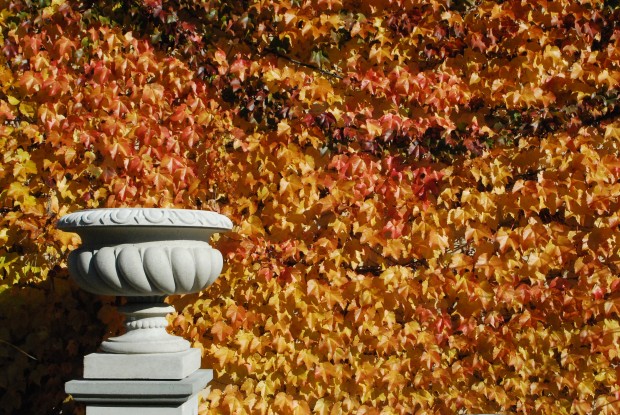

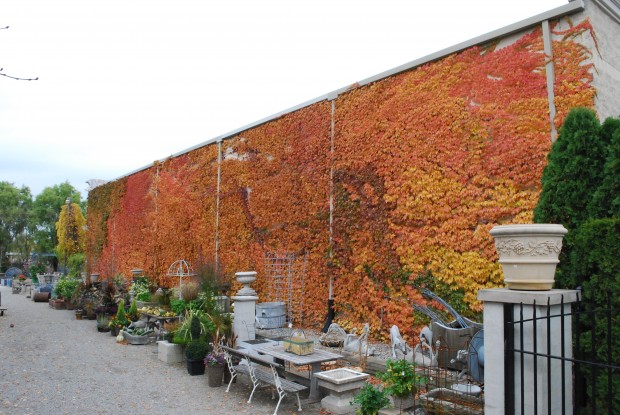
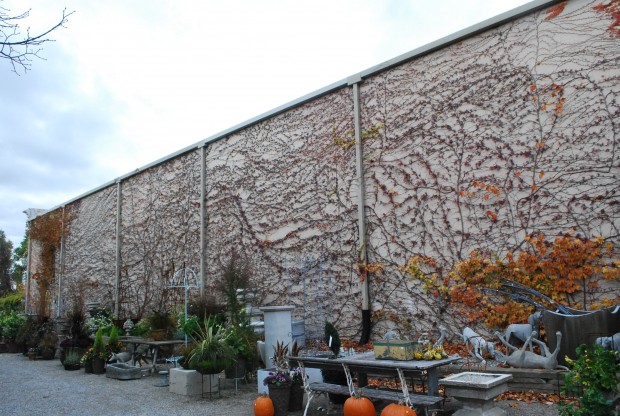
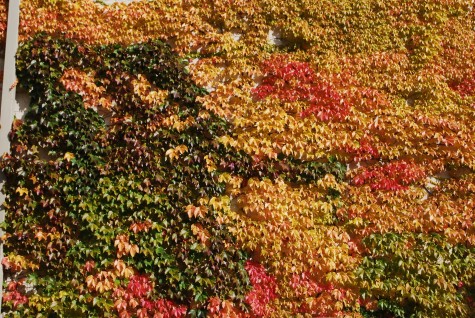 I have never forgotten my ninth grade science teacher, Dr. Watson. He concluded every lecture or discussion with the statement, “And that is the beauty of science”. Though at the time I thought he was a crackpot, I now know he was absolutely right. Today I am thinking about Parthenocissus Tricuspidata; Boston Ivy is an ordinary plant with a fancy scientific name whose primary claim to fame is its ability to grip to and cover walls with dense sheets of leaves. Why today? The fall color of Boston Ivy is one of nature’s most spectacularly glowing moments, ranking right up there with the aurora borealis.
I have never forgotten my ninth grade science teacher, Dr. Watson. He concluded every lecture or discussion with the statement, “And that is the beauty of science”. Though at the time I thought he was a crackpot, I now know he was absolutely right. Today I am thinking about Parthenocissus Tricuspidata; Boston Ivy is an ordinary plant with a fancy scientific name whose primary claim to fame is its ability to grip to and cover walls with dense sheets of leaves. Why today? The fall color of Boston Ivy is one of nature’s most spectacularly glowing moments, ranking right up there with the aurora borealis. 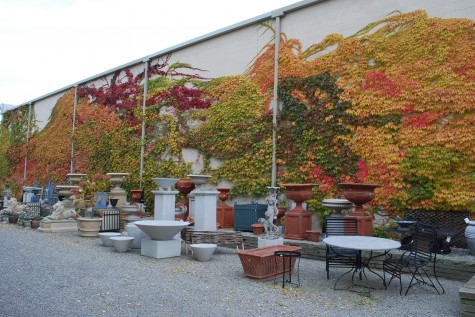 One wall of the building next door to me sits right on my property line; that would be just about two thousand square feet of beige concrete block. Needless to say, I was not too crazy about the look. Five Boston Ivy plants have just about transformed that wall in four years time; today it is looking exceptionally good. The science behind all this color-the formation of the abcission layer. Don’t black out; I’m talking about the beauty of science here. As soon as the nights get long enough in the fall, the cells that connect the leaves to the stems begin to rapidly divide-but they do not expand. This produces a brittle callus, which slows, and finally prevents the flow of nutrients from the stem to the leaves. The plant is going dormant, and putting any expenditure of energy on hold. This is a survival mechanism, the instinct to preserve life, and the beauty of science.
One wall of the building next door to me sits right on my property line; that would be just about two thousand square feet of beige concrete block. Needless to say, I was not too crazy about the look. Five Boston Ivy plants have just about transformed that wall in four years time; today it is looking exceptionally good. The science behind all this color-the formation of the abcission layer. Don’t black out; I’m talking about the beauty of science here. As soon as the nights get long enough in the fall, the cells that connect the leaves to the stems begin to rapidly divide-but they do not expand. This produces a brittle callus, which slows, and finally prevents the flow of nutrients from the stem to the leaves. The plant is going dormant, and putting any expenditure of energy on hold. This is a survival mechanism, the instinct to preserve life, and the beauty of science. 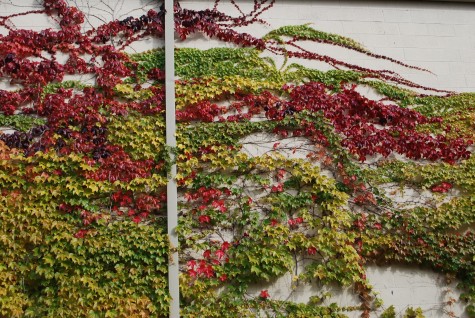 At the same time, the leaves slow down and eventually quit producing chlorophyll-that chemical that makes leaves green. If chlorophyll is not constantly manufactured in a leaf, the leaf will fade in sunlight. Chlorophyll masks the other pigments existing in leaves; the yellows, oranges and reds that were there all along are revealed when the production of chlorophyll ceases.
At the same time, the leaves slow down and eventually quit producing chlorophyll-that chemical that makes leaves green. If chlorophyll is not constantly manufactured in a leaf, the leaf will fade in sunlight. Chlorophyll masks the other pigments existing in leaves; the yellows, oranges and reds that were there all along are revealed when the production of chlorophyll ceases. 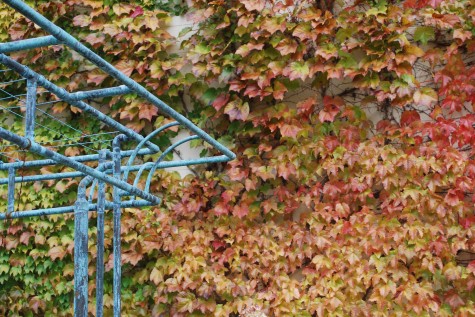 Though day length triggers this process, the temperatures, the moisture in the soil, and sunlight influence the overall show. A dry growing season can encourage leaves to drop early before they reveal any color. High winds can sever the dry corky abscission layer with the same result. At any rate, the variation and intensity of color on this wall is different every year given weather conditions. I can see that light, water, wind, sun and overnight temperatures affect the leaves on wall at different rates.
Though day length triggers this process, the temperatures, the moisture in the soil, and sunlight influence the overall show. A dry growing season can encourage leaves to drop early before they reveal any color. High winds can sever the dry corky abscission layer with the same result. At any rate, the variation and intensity of color on this wall is different every year given weather conditions. I can see that light, water, wind, sun and overnight temperatures affect the leaves on wall at different rates. 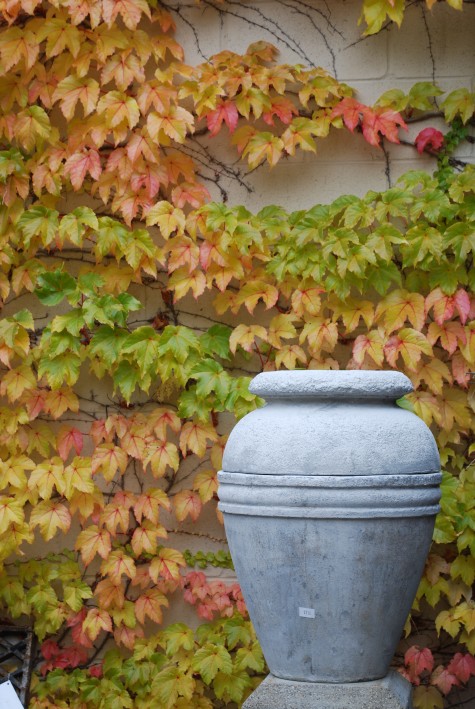 It is easy to see the chlorophyll fading at different rates in different leaves-the color variation within each individual leaf is beautiful.
It is easy to see the chlorophyll fading at different rates in different leaves-the color variation within each individual leaf is beautiful. 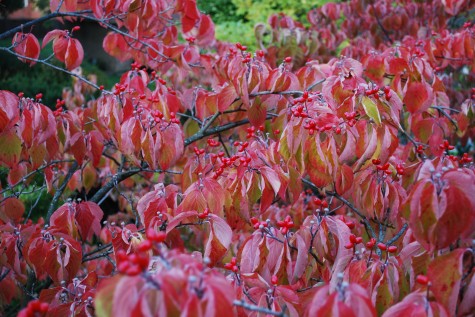 Anthocyanins are responsible for the red and purple pigments in leaves. They are manufactured from sugars that are trapped in the leaf. Oddly enough, these pigments are not present in leaves during the growing season. The role of these pigments is not so well understood. If you are interested in reading more about it, The United States National Arboretum has an excellent article on line about the science of color in autumn leaves.
Anthocyanins are responsible for the red and purple pigments in leaves. They are manufactured from sugars that are trapped in the leaf. Oddly enough, these pigments are not present in leaves during the growing season. The role of these pigments is not so well understood. If you are interested in reading more about it, The United States National Arboretum has an excellent article on line about the science of color in autumn leaves.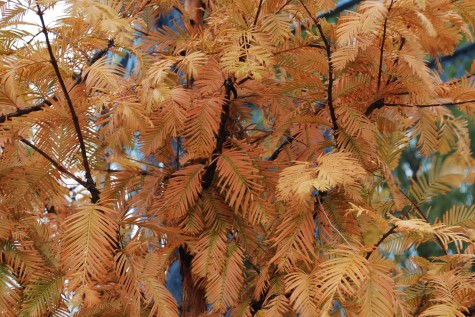 Metasequoia Glyptostroboides-I wish this were my name. The Dawn Redwood is an ancient evergreen tree with a twist; it drops its needles in the fall, after turning this glorious peachy orange. This deciduous evergreen is an anomaly amongst evergreens, which ordinarily hold their foliage all winter.
Metasequoia Glyptostroboides-I wish this were my name. The Dawn Redwood is an ancient evergreen tree with a twist; it drops its needles in the fall, after turning this glorious peachy orange. This deciduous evergreen is an anomaly amongst evergreens, which ordinarily hold their foliage all winter. 